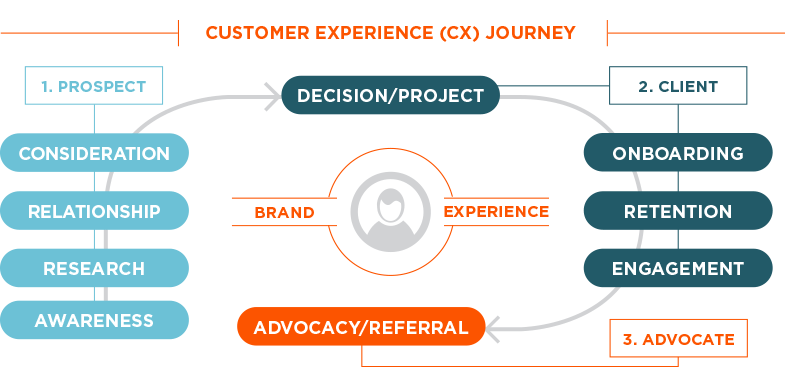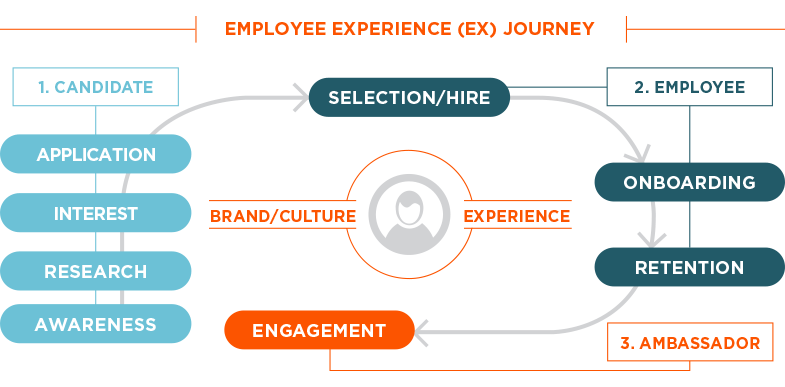
Today’s leading companies are beginning to recognize the powerful connection between the Customer Experience and Employee Experience. However, connecting the dots requires an alignment of business and marketing; strategy and technology; brand and culture; and client and employee. The design and implementation of Experience must be fully integrated into a company’s corporate DNA – from its long-term strategy to daily actions and across all functions, departments and communications.
And every company needs an Experience leader, champion and change-maker. This creates an opportunity for marketing.
Customer Experience (CX) is the sum of all interactions between a company and its customers. Customer Experience is how a company delivers on its brand promise to customers. Customer Experience is not the same as customer service or customer satisfaction – CX encompasses all ways in which a customer interacts with a brand across the entire customer journey.
Employee Experience (EX) is the sum of all interactions an employee has with a company – from recruitment through employment to exit interview. Employee Experience is not an HR function – HR is only a part of it. EX includes everything from physical work environment to operations, communications, culture and more.
Because a company’s brand is the sum of all perceptions that exist in the minds of its audiences, both Customer and Employee Experience dramatically impact how the brand is perceived and remembered, because they affect how the brand is experienced – for better or worse.
The answer is both!
Prioritize employees over customers, and you will have happy employees who don’t deliver the right results or don’t deliver on your firm’s brand promise to customers.
Focus on customers only, and you’ll likely see a high rate of employee turnover due to lack of engagement or toxic culture.
Traditionally, Marketing’s responsibility began and ended with the managing of the company’s brand, creating the company’s marketing plan and executing marketing campaigns.
Things such as culture, Customer Experience, and employee recruitment and engagement were left to executive leadership; sales, account management or customer service; and HR and training and development.
As a result:
Then something changed. Business leaders connected the dots between their brand and the bottom line. They realized that a direct connection exists between increased brand equity and tangible business benefits and that brand should be the key driver in shaping the Customer and Employee Experiences.
This creates a problem for Marketing.
If Marketing is responsible for the brand but not for shaping how it’s experienced, this will create a disconnect between brand strategy and brand expressions, between culture and Employee Experience, between brand promise and Customer Experience, and more.
Effective branding requires unity across all Experiences.
The struggle for Marketing is the fact that the responsibility for customers and employees is in the hands of others.
However, no other business function is better positioned to bring unity and create collaboration across departmental silos when designing and managing CX and EX than Marketing.
Why Is Marketing in the Best Position to Take Charge?
According to a recent B2B Marketing report, “B2B Customer Experience Management: A Marketer’s Guide,” there are several common qualities that all Experience champions share, including:
Marketing checks all the boxes!
Additionally:
So how does Marketing become the Master of the Experience for companies?
Also read: Taking Customer Experience Firmwide: Marketing’s Role
Today, the Experience is often treated as a series of separate initiatives with separate strategies, agendas, activities and teams. In the traditional setting:
As a result, the brand is fragmented and inconsistent, the process is fragmented and inconsistent, and the Experience is fragmented and inconsistent.
According to the fourth annual State of Marketing report by Salesforce, 64% of marketing leaders believe Customer Experience strategies require redefining how service, sales and marketing work together.
Future success relies on full integration – no company can create a seamless Customer or Employee Experience if its internal structure doesn’t support it. Operations, marketing, sales, IT, HR, technical and project management all must work together in service of creating a more consistent and rewarding Experience for any and all of their company’s audiences.
And until there’s a unifying force across all functions and departments, it will continue to result in a fragmented and inconsistent Experience.
By bringing together all teams, messages and communications, Marketing can align the entire company around the brand vision and create Experiences that help to achieve that vision for both clients and employees.
Open communication and ongoing collaboration across all departments is critical, but this is only step one. What’s also necessary is an alignment of:
And:
Begin by understanding your company’s customers – internal and external. Learn what they want and need, and then make sure that your entire Experience is designed to serve those needs.
This deeper level of understanding requires rigorous and ongoing research and data mining across the entire Experience journey to help inform the development of meaningful customer and employee personas.
Your Ultimate Guide to Better Customer Insights [free download]
Personas provide a deeper dive into the personalities, challenges, goals, values and personal agendas that characterize your primary customer and employee groups.
Although the basic demographic information (age, gender, industry, education, etc.) helps to define the overall archetype, the real insight comes from getting to know each audience group on a deeper, more intimate, personal and emotional level.
Creating detailed and actionable personas not only will help you identify with your audiences more and better solve their problems but also will result in creating a better experience.
Tips For Creating Better Buyer Personas [free download]
Map out Experience journeys for each customer and employee persona type. One of the primary benefits of journey mapping is that it allows you to see your firm’s Experience through the eyes of its customers and employees.
You could develop both journeys using the same model. The number of stages and their naming conventions will vary, and there will be a multitude of touchpoints, interactions and meaningful moments within each stage that you also will need to define, but the general path is relatively similar – from prospect to client to advocate and from candidate to employee to brand ambassador.


Now that you’ve developed meaningful personas and mapped a journey for each, the next step is to identify and document the most influential touchpoints, where your customers and employees come in contact with your company.
The touchpoint audit should encompass all departments and functions of the company – not just marketing.
Customer Experience Journey and Touchpoints Templates [free download]
For each stage of the journey and each touchpoint:
Take into account what each persona needs and wants and how you want them to think and feel about your company at each stage in the journey.
Finally, identify departments and teams responsible for specific actions your company will have to take in order to deliver the desired Customer and Employee Experience across the entire journey.
Why Should Marketing Want to Take Charge?
What’s driving growth for companies today is creating exceptional Experiences for both customers and employees. CX and EX have become an executive priority.
Forrester’s “Predictions 2019: Customer Experience” report states that 76% of executives say improving CX and EX is a high or critical priority and many companies have established a C-level position to oversee it.
A study from Accenture Interactive states that 90% of Experience decision makers agree that the CMO should be the internal advocate for their customers.
And for Marketing, which often struggles to prove its value and earn an equal seat at the executive strategic table (especially in professional services and other technical fields), this creates an opportunity to be at the center of what matters for their companies.
Leading the Experience charge is how marketing can create measurable value – for a company and for the marketing function within a company.
More and more companies are hiring Chief Experience Officers, but in the absence of that, it’s increasingly becoming Marketing’s role to lead the way in aligning brand, CX, and EX in many industries.
In the Forbes article “Why The M In CMO Should Be An X,” Shep Hyken says:
Maybe you’re not ready to replace a CMO with a CXO. But consider adding the X and creating a CMXO, Chief Marketing and Experience Officer. It’s a step in the right direction.
There’s no question about the critical need for aligning Customer and Employee Experience.
The only question is: Who is the best person within your company to do it? And do you want to have marketing take charge or let it go to someone else?
Download a free PDF of this article here.